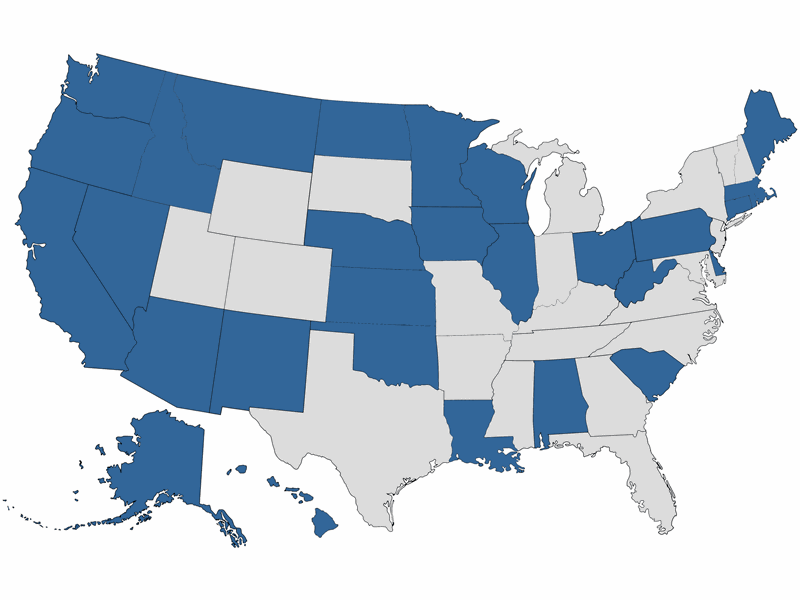Incidents, Outcomes and Climate Surveys
What is Available?
The data reflects performance in the areas of facility safety, order and security; health, behavioral health, substance use, education and reentry services; connection with families, perceptions of fairness and staff-youth relationships. The database contains demographic variables that can be sorted, such as facility geographic location, size, type and gender served. The data has been organized into datasets available for the surveys listed below for multiple data collection periods beginning April 2010. Several surveys have undergone minor changes (e.g. addition of questions, changes of phrasing and tense). The differences are reflected in the datasets and are noted in a separate downloadable codebook. All datasets are presented in a standard Excel file format.
The Administrative Form provides both general and specific information about each facility. One form is completed per facility per data collection. Questions range from numbers of youths and staff to types of assessments as well as the number of facility programs using volunteers.
Each facility completes an Incident Report for any event or that may compromise the security of the facility or the safety of staff, youths or visitors. Approximately 6,500 Incident Reports are collected each data collection.
Data collected includes:
- Youths Involved
- Staff Involved
- Assaults/Fights
- Restraints
- Injuries
- Medical Visits/Examinations
- Isolation and Room Confinement
- Segregation
PbS Outcome Measures numerically express the change in status of the prevalence of an occurrence or in the rate or frequency of events and indicate the extent to which practices and policies are being implemented. Linked to the PbS standards, they offer facilities a way to assess how well they are meeting the standards and in what areas they need to improve. There are more than 100 outcome measures indicating performance in nine domains of facility operations and services:
- Behavioral Health
- Family
- Health
- Justice
- Order
- Programming
- Reintegration
- Safety
- Security
Twice a year, during April and October, all facilities administer the PbS Staff Climate Survey to 30 randomly selected direct care staff who are employed at the facility during the data collection. Approximately 5,000 surveys from staff are collected each data collection.
The survey collects feedback from staff on:
- Safety and Security
- Training
- Living and Working Conditions/Climate
- Facility Programming
- Staff-Youth Relationships
Twice a year, during April and October, all facilities administer the PbS Youth Climate Survey to 30 randomly selected youths residing in the facility during the data collection. Approximately 4,000 surveys from youths are collected each data .
The survey collects feedback from youths on:
- Living Conditions/Climate
- Understanding Rules and Rights
- Facility Programs
- Family Contact
- Safety and Security
- Staff
- Justice
Database users can select a survey and timeframe to generate a codebook and dataset. Below are examples of rows that might appear in a Staff Climate Survey codebook and dataset.
Codebook – Each row corresponds to unique question text and indicates the variable, answer options, and survey versions associated with the question text.
|
Sheet Name |
Variable |
Question Text |
Multiple Options |
Version Number |
|
Staff Climate |
Are Rewards Used To Influence Behavior |
Are incentives and rewards used to influence residents' behavior? |
Yes | Sometimes | No |
1 | 2 | 3 | 4 |
|
Staff Climate |
Are Rewards Used to Influence Behavior |
Does the facility use incentives and rewards to influence youths’ behaviors? |
Yes | Sometimes | No |
5 | 6 | 7 | 8 | 10 |
Dataset – Each row corresponds to a unique survey and includes other information about where and when the survey was collected.
|
Survey ID |
Survey Version |
Collection Period |
Respondent ID |
Setting |
Type |
Are Rewards Used To Influence Behavior |
|
49873 |
10 |
Apr 2019 |
Facility123 |
Rural |
Correction |
Yes |
|
809 |
2 |
Apr 2011 |
Facility113 |
Urban |
Detention |
Sometimes |
Examples of PbS Data Contributing to Research
PbS Data in Action
PbS data addresses topics in the areas of safety, order, security, health, behavioral health, family and social supports, justice, programming and reintegration with the goals of making facilities safe, monitoring program effectiveness and achieving positive outcomes. Our datasets offer thousands of statistics about juvenile assessment, corrections and detention centers across the country.
The comprehensive and current database allows researchers to identify consistencies, disparities and trends related to ethnicity, gender and race, as well as facility location, region and type. Additionally, our data is relevant to conversations at the forefront of juvenile justice today, including positive youth development, family engagement, behavior management, confinement, mental health and, substance use services, trauma-informed care and reentry.
The findings of researchers from accredited institutions and a variety of disciplines—including criminology, law and legal studies, political science, psychology, social work and sociology—have led to positive change in practices and policies across the juvenile justice field.

Research Brief: Pathways of Racial-Ethnic Disparities in Juvenile Corrections
University of Arkansas at Little Rock 2023

Research Brief: Family visitation, behavioral incidents, and staff safety: What changed in the COVID-19 era?
Randolph-Macon College 2022

Research Brief: Perceptions of Educational Reentry Preparedness among Detained and Committed Youth
Florida State University 2022

Increased Family Visitation Leads to Fewer Incidents and Less Staff Fear
Georgetown University 2020

Research Report: PbS Data for Correction and Detention Facilities, 2004-2010
New Amsterdam Consulting, Inc. 2011
Apply for Access
Prospective researchers must submit an application, including a research proposal, that will be reviewed by a committee. Applications are accepted continuously and are reviewed and approved on a monthly basis.
Learn More About the PbS Database for Researchers
Ask a Question
Are you interested in learning more about the PbS Database for Researchers? A member of the PbS Help Desk team will promptly respond to your message.


